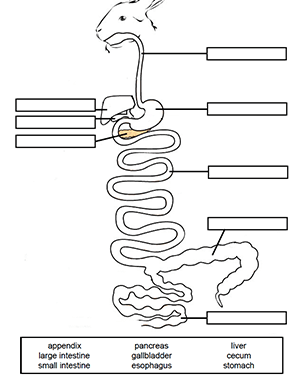
Students in biology may or may not do extensive dissections, but most biology classes do include a unit on comparative anatomy.
Many teachers substitute dissections with virtual labs or paper versions of dissections where students label, color, or cut out parts. This worksheet shows a simplified diagram of a human and a rabbit digestive system where students label the main structures using a word bank.
Discussion questions ask students to compare the anatomy of the two organisms, with the most obvious difference being the size of the cecum. In rabbits, this structure helps digest plant material. It is reduced in humans and has a tiny appendix attached.
Another major difference between the rabbit digestive system is the length of the small intestine. Herbivores have much longer small intestines because plant material takes longer to digest. Carnivores have shorter small intestines, and omnivores, like humans have a medium length.
I gave my students this activity after dissection of the frog, so they had a background with the structures of the digestive system, but you could easily use this as a whole class activity where you go over the diagrams and answer the questions together.
Here is another image that might be useful. It is not exactly the same, but I find with my anatomy students that they struggle with transferring knowledge to new diagrams. I stress that the goal is not to memorize a diagram, but to understand how the parts fit together. For an extra challenge, you can show them this diagram as a way to label the one in the worksheet.
Related Activities
Carrying Capacity and Rabbits – explore how rabbit populations grow exponentially after introduction into England
Saving a Fussy Predator – reintroduction of the lynx to control rabbit populations
Rabbit Skeleton – model for use in comparative anatomy, showing teeth and skeletal features

